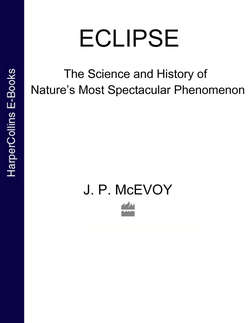Читать книгу Eclipse: The science and history of nature's most spectacular phenomenon - J. McEvoy P. - Страница 11
THE MOON AND THE EARTH: PHASES
ОглавлениеOne aspect of the Moon’s motion which is important for understanding eclipses is the cycle of the phases it presents to the Earth during the course of a month. This is illustrated in Figure 1.3. New Moon marks the start of the cycle, when the Moon cannot be seen because it is in the same direction as the Sun and the illuminated, sunlit side faces away from the Earth. A day later, however, the Moon has moved away from the Sun and is seen as a slim crescent in the evening sky just after sunset before disappearing over the horizon. A few days later, the waxing, growing Moon is seen higher in the sky, now increasing its angular distance from the Sun at a rate of just over 12° per day. (It moves through one complete cycle of 360° in a little over 29.5 days, a period called a synodic month.) Between the 7th and 8th days the Moon reaches first quarter, making a right angle with the Sun as seen from the Earth, and the right half of the Moon is now illuminated. Between the 8th and 15th days the illuminated portion continues to grow until midway through the cycle, when full Moon is reached.
At full Moon the entire lunar disk is illuminated and 180° separate the Moon from the Sun. It is in this position that a lunar eclipse is possible, depending on how close the full Moon is to one of its nodes. As the month plays out, the illuminated portion decreases. The waning Moon reaches third quarter after about 22 days, when only the left half is illuminated. The Moon again makes a right angle with the Sun as seen from the Earth. The Moon will rise before the Sun, visible in the morning sky. After last quarter the Moon moves closer and closer to the Sun, showing a progressively thinner crescent. On the 27th and 28th days the Moon is seen only just before sunrise, a sliver in the morning sky as new Moon approaches. After 29.5 days the Moon passes out of view again at new Moon. If the new Moon is close enough to one of its nodes a solar eclipse will occur. After new Moon, the cycle starts all over again. Figure 1.3 shows that a lunar eclipse can occur only at full Moon, and a solar eclipse can occur only at new Moon.
Figure 1.3. The four chief phases of the Moon and the times when eclipses can occur.
